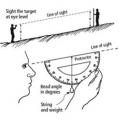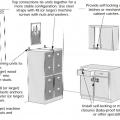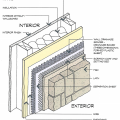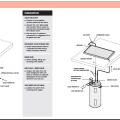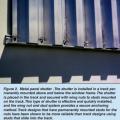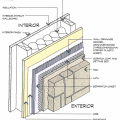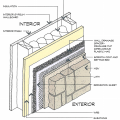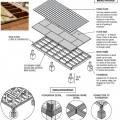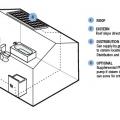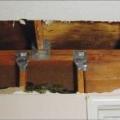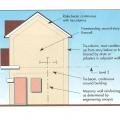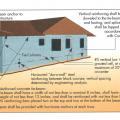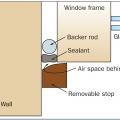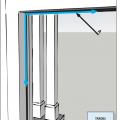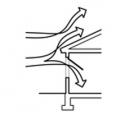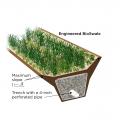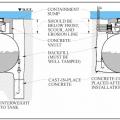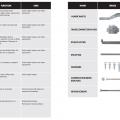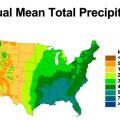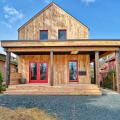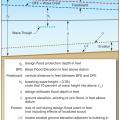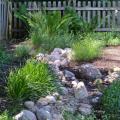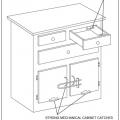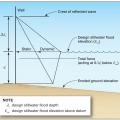Showing results 1 - 50 of 489
A combination of brackets and self-locking drawers. Drawer closures should be used to protect the home during seismic events.
A continuous drainage mat rainscreen made from vacuum-molded plastic provides uniform support for the siding and allows moisture to flow horizontally and diagonally in addition to vertically.
A continuous load path uses structural connections to transfer horizontal and vertical loads from the roof to the foundation to help keep the building intact in high-wind and seismic events
A drywell, shown here used for downspout catchment, can also be used to receive water from a French drain.
A flat plate solar hot water system heat potable water in a glass covered collector that sits on the roof.
A French drain contains a perforated drain pipe wrapped in rock and landscape fabric.
A gable end failure due to improper bracing caused collapse of most of the trusses on this roof under hurricane force wind conditions.
A masonry chimney is reconstructed to withstand seismic forces by adding an insert to the existing firebox
A masonry chimney is reconstructed to withstand seismic forces by completely retrofitting the firebox and chimney using light-frame construction on the top of the foundation
A masonry chimney is reconstructed to withstand seismic forces by maintaining the current firebox but replacing the chimney section with a metal flue and light-weight chimney enclosure.
A masonry chimney is shortened and capped at roof level to reduce its chances of detaching in high winds or earthquakes; the fireplace can no longer be used.
A metal storm panel is installed in a track permanently mounted above and below the window frame and secured with wing nuts to studs mounted on the track.
A molded plastic drainage board rainscreen allows vertical drainage while providing uniform support for the siding and resisting compression from screws and nails.
A plastic fiber drainage mat rainscreen provides uniform support for the siding and allows moisture to flow horizontally and diagonally in addition to vertically.
A raised wood pier foundation can raise the subfloor above the design flood elevation.
A resilient home with storm shutters, a sump pump that drains to a french drain, rainwater collection, solar thermal and PV, and raised garden beds.
A resilient multifamily building in Puerto Rico constructed of concrete on a raised slab foundation with a hip roof design for wind resistance and deep overhangs and permanent awnings to keep sun and rain off windows.
A self-sufficient water system for a home could include a rooftop cistern and solar thermal water heater.
A shallow, open floor plan allows free flow of cross ventilation through the house
A single-story house floor plan showing braced wall line locations at A through E and 1 through 5
A swale and berm can be installed together across a slope to slow the downhill flow of water.
A thermosiphon solar hot water system heats a fluid in the solar collector; the heated fluid heats potable water in a roof top tank.
Accordion-type hurricane shutters protect sliding glass doors from high winds and wind-borne debris.
Add metal connectors to strengthen framing connections in an existing wall from inside the home by removing drywall.
Adding planted terraces to a sloped yard can slow down runoff and reduce erosion
Air seal door and window rough openings with backer rod, caulk, or nonexpanding foam
Airflow can be directed across thermal mass in the ceiling, floor, or elsewhere inside the home through various window and louver configurations
An engineered bioswale uses perforated pipe laid in rock and landscape fabric at the bottom of a vegetated trench to direct water away from a site.
An underground fuel tank is anchored onto poured-in-place concrete counterweights.
Anchorage failure in sliding glass doors due to negative pressures from hurricane force winds.
Anchoring hardware is used to tie down equipment and components of the home to resist high winds and hurricanes.
Awnings and overhangs should have strong and continuous connections to resist wind forces that might pull them off the structure.
Backup generators usually run on gas, propane, or diesel-powered and typical sizes for homes generate 2,500 to 7,500 watts.
Berms are compacted earth or gravel ridges that slow the flow of water from rain, riverine flooding, or storm surges in coastal areas.
Berms, swales, bioswales, ridges, and vegetation all help to control rainwater runoff on residential sites.
Bioswales or rain gardens filter storm water through vegetation and rock and sand substrate layers.
